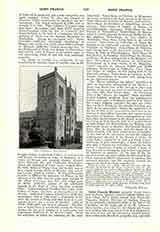

Saint Francis Mission (properly SAINT FRANÇOIS DE SALES, Quebec), a noted Catholic Indian mission village under Jesuit control near Pierreville, Yamaska district, Province of Quebec, Canada. It was originally established (1683) at the falls of the Chaudière, on the south side of the St. Lawrence, above Quebec, as a refuge for the Abnaki and Pennacook Indians who were driven from New England by the wars of that and the subsequent colonial period: these tribes were French in sympathy and, especially the Abnaki, largely Catholic in religion through the efforts of the Jesuit missionaries. The Algonquin, Montagnais, and Micmac of Canada as well as the Nipmuc and others of southern New England were also largely represented, but from the final preponderance of the Abnaki their language became that of the mission. In 1700 the mission was removed to its present situation. After the destruction of Norridgewock and the death of Father Sebastian Basle at the hands of the New England men in 1724, the majority of the Abnaki removed to Canada and settled at Saint Francis, which became thenceforth a center of Indian hostility against New England. In 1759 a strong New England force under Major Rogers surprised and destroyed the settlement, including the mission church and records, killing 200 Indians. It was soon rebuilt and still exists as one of the oldest mission settlements of Canada. In the war of the Revolution and again in the war of 1812, a number of the men fought on the British side. Among the Jesuit workers at St. Francis the most distinguished name is that of the venerable Father Joseph Aubery, in charge from 1709 until his death in 1755, who before coming to the mission had served ten years with the Micmac of Nova Scotia. Having mastered the Abnaki language he wrote much in it, his most important contribution being a manuscript French-Abnaki dictionary, which is still preserved in the archives of the mission. Owing to the former migratory habit of the Indians the population of the mission varied greatly at different periods, but is estimated today (1911) at approximately three hundred souls, all of mixed blood, and more French than Indian in characteristic, although they still retain their old language in their homes. Their chief industry is basket-making, which furnishes a comfortable income. (See also Penobscot Indians; Missions, Catholic Indian, of the United States.)
JAMES MOONEY

